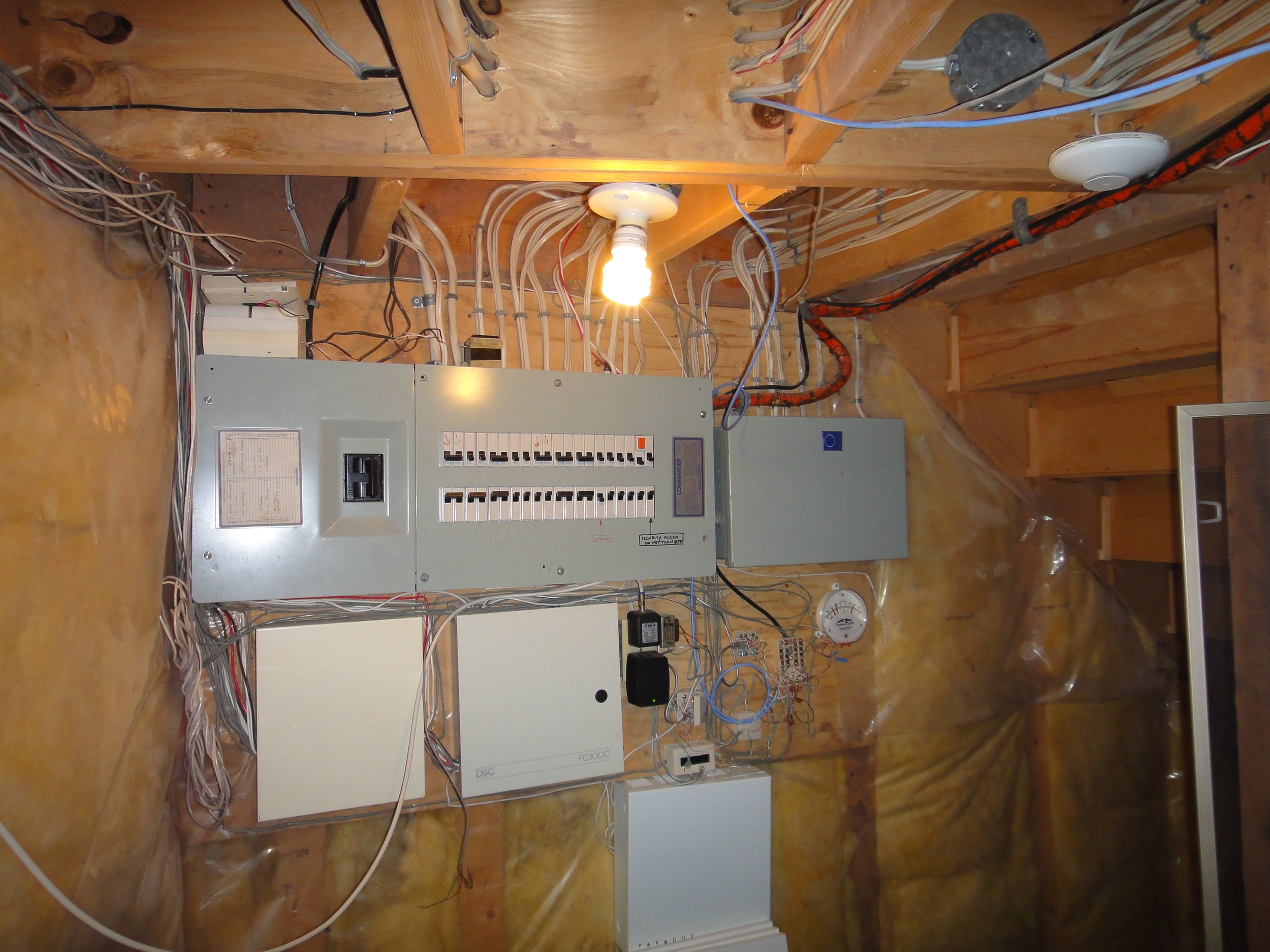I previously posted a short piece on Knob and Tube. As wiring goes, it’s very easy to identify and most people know that at the very least, it should be assessed by an electrician.
This piece is intended to provide a brief description of the rest of the wiring that is common in homes. Have you ever noticed the writing along the length? It describes various things like the manufacturer and the testing and safety standards they were built to meet. You are also likely to see ‘NMD’ with a number, such a NMD 7 or NMD 90. ‘NMD’ stands for ‘non-metallic dry’. It means the jacket, or the sheathing, around the wire is not a metallic material and it’s for dry locations. Other types of wiring may have a metal sheathing or be rated for exterior and/or wet conditions.
NMD 1 - 1950-1962
This was the first type of wiring that bound the hot and neutral wires (white and black, typically) together into a secondary sheathing which was made from a woven fabric infused with a tar-based material. This type offered additional protection to the wiring versus the single layer of the knob-and-tube wires. This type was similar to knob-and-tube in another way. There was no ground wire. The receptacles still had two slots without the rounded hole. This type of wiring had sheathing that was rated to 60°C. In some cases with modern electrical use, this may not be sufficient.
If this system is in your home, it’s a good idea to have an electrician assess it. The outlets can be replaced with GFCI outlets to provide grounding at those points and the electrician can determine if certain areas would be better served with newer wiring or additional circuits.
NMD 3, NMD 6 - 1962-1984
NMD 3 is essentially the same as NMD 1 but it was the first that included a ground wire. Three prong outlets were introduced.
NMD 6 was an improvement over NMD 3, as it had a sheathing that was rated for 75°C which provides more tolerance for heavier electrical loads.
NMD 7, NMD 90 - 1984-present
NMD 7 introduced the vinyl sheathing. Not only was it much easier for the electrician to pull through walls, but it had a temperature rating of 90°C. I’ll give you three guesses why it was later called NMD 90.
Aluminum - 1965-1974
All of the types listed above use copper as the conductive material. For about 10 years, during a time that copper prices were quite high, aluminum was used as a less expensive alternative. It can be identified as ‘aluminum’ or ‘AL’ written on the sheating. The bare wires are silver in colour.
There are several issues with aluminum wiring. A person may buy a house without knowing it has aluminum wiring may replace a light fixture or an outlet which has standard copper connections. Because copper and aluminum can corrode when in contact with each other, shorts, sparks, and fires can occur.
It turns out that even original installations can be problematic. Original aluminum-compatible outlets were not always adequate. Electricians inspecting these devices often note scorching on the devices. In addition, because aluminum is malleable and expands and contracts with temperature changes, overtightened connections at fixtures and in the electrical panel can loosen over time causing shorts and sparks.
All aluminum installations really should be inspected by an electrician to ensure everything is in safe working order.
Wire Gauges for Copper Wiring (aluminum wiring requires heavier gauges for each purpose)
The wire gauge and number of conductors can also be found written on the wire sheathing. Newer wiring also has colour coded sheathing. The colour is indicated in brackets beside each wire type. The colour only indicates the gauge of the conductors; not the number of conductors.
See below for the common types in a conventional new home:
14-2 (white)
Most wiring in the house will be 14 gauge with two conductors; the hot (black) and the neutral (white). It’s referred to as 14-2. 14 gauge wire is served by a 15 amp breaker. This is what generally brings power to the lights and outlets in the house.
12-2 (yellow)
This is a 12 gauge wire with two conductors. With wire guages, a smaller number indicates a thicker wire. Heavier gauge wiring is necessary for heavier electrical loads. For example, an option for kitchen wiring is to serve the outlets with 12-2 wiring. This is served by a 20 amp breaker. The higher service allows for countertop appliances to draw more power.
14-3 (white)
If you’re paying attention, you’ll notice that this type has 14 gauge wire, but now there are three conductors? That’s right. In addition to the black (hot) and white (neutral) there is also a red wire. This is a second hot conductor. This can serve a couple of purposes. Firstly, they allow for three-way switches to work.
Three-way switch: A regular switch works by simply opening and closing the circuit as you flip the light switch. Picture a drawbridge lifting up preventing the cars from driving across. Turn the switch on, and the drawbridge lowers allowing cars to cross again. With a three-way switch, it allows two different paths for the electricity to flow. Picture two bridges side by side that lead to a single road at each end of the bridges. Also picture a ramp that pivots from the road to switch back and forth to each bridge. When each pivoting ramp is switched to the same bridge, traffic can flow. When they are on different bridges, no traffic can flow.
The other use for 14-3 is supply two different circuits in one sheathed cable. Each of the hot conductors are connected to their own circuit breaker, and they each serve different areas. This is how split receptacles are powered by two separate circuit breakers.
10-3 (orange)
By now the pattern should be easy to follow. This is 10 gauge wire with three conductors (and a ground wire, of course). This wiring is typically used for an electric dryer.
8-3 (white)
This is 8 gauge wire with three conductors and a ground wire. This wiring is typically used for electric ranges.
Other Colours
Blue sheathed wire is 14-2 with a coloured sheathing indicating that the wire is served by an AFCI (arc fault circuit interrupter). Pink sheathed wire is 14-2 with a black conductor and a pink conductor. This is used for situations where two hot conductors are required and no neutral conductors are needed. The most common example is a central air conditioning unit.
Please note:
The information provided above is just one person's knowledge and understanding of the systems described. It is not meant to supercede or replace any applicable authority or electrician's expertise. While a home inspector may be very knowledgeable about household wiring, an electrician should always be contacted to determine with certainty if any particular electrical situation is acceptable and safe.

